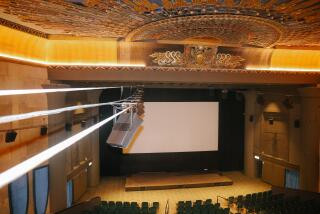Motion Picture History Has Future in Permanent New York Exhibit
- Share via
NEW YORK — Greta Garbo throws her head back and laughs in a scene from the 1933 movie “Queen Christina.” Her mirth seems natural, but the film’s director now reveals that Garbo told him she could display any emotion, but she could not laugh.
Rouben Mamoulian told the actress to play the scene as best she could. But as the cameras began to roll, he made funny faces off-camera at the appropriate moments and Garbo . . . laughed.
“Every human being is a mystery,” Mamoulian said. “They have some secrets there. It’s a great joy to be able to bring them out.”
Mamoulian’s commentary can be heard as the movie scene unfolds at a permanent exhibit at the country’s first museum dedicated to the art, history and technology of film, television and video. The American Museum of the Moving Image, which opened Saturday in Queens, N.Y., is the brainchild of Rochelle Slovin, who was appointed executive director of the Astoria Motion Picture and Television Foundation in 1981.
The museum is located on the site of the Astoria Studios, once the East Coast production facility for Paramount Pictures, where the silents and talkies of the early motion picture days were filmed.
Slovin has overseen the creation of the $15-million facility, which will feature permanent and changing exhibitions that combine historic memorabilia with technological displays. She looked at American institutions that deal with the motion picture industry and found a gap, according to Robert Herman, the museum’s director of public relations.
“There are fine archival museums of television shows and movies, but no institution collects the material culture of the movies and television,” Sherman said. “So that is the breach we just stepped into.”
The museum will combine the exhibitions with 700 screenings each year “so it will be very much a living institution that both collects and displays the television and videos it comments on,” Sherman added.
The exhibits in the three-story, 50,000-square-foot building are a hands-on experience. In the current visiting exhibit, “Masterpieces of Moving Image Technology,” a visitor can hand-crank an 1895 device that flips a reel of 2 1/2-inch photographs to create the illusion of motion.
Home moving-image entertainment dates back to late 19th Century, when wealthy families used toy versions of magic lantern shows as parlor games. The temporary exhibit also houses the first motion picture camera--Thomas Edison’s 1891 Kinetograph Camera. The display includes 56 other movie cameras and a range of television sets. A visitor can also see Bell Laboratories’ first Picture Television, which linked participants in Washington and New York on April 7, 1927, receiving sound and picture by wire and wireless.
The permanent exhibit, “Behind the Screen: Making, Marketing and Exhibiting Motion Pictures and Television,” is a guide to who does what in motion pictures and television. Housing 60,000 artifacts, the exhibit ranges from scenery (Paul Newman donated the 1987 film set of “The Glass Menagerie”) to props, photographs, costumes, movie posters, fan magazines and technological apparatus.
On a placard describing a display of movie and television-related products, visitors learn that while the “Star Wars” trilogy made more than $1.26 billion in ticket sales, “it earned twice that from movie-related products.”
The most ambitious exhibit is “Tut’s Fever,” a life-scale 16-millimeter theater designed by artists Red Grooms and Lysiane Luong in the neo-Egyptian style that was popular in the 1920s. Mae West stands behind the concession stand, offering “Tut’s Nuts” to moviegoers. Mickey Rooney is dressed as an usher and holds a flashlight, so visitors don’t trip on their way out of the crypt behind the 40-seat room.
More to Read
The biggest entertainment stories
Get our big stories about Hollywood, film, television, music, arts, culture and more right in your inbox as soon as they publish.
You may occasionally receive promotional content from the Los Angeles Times.










